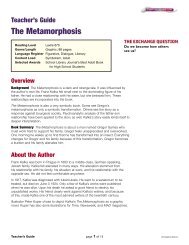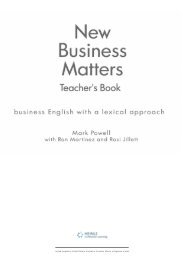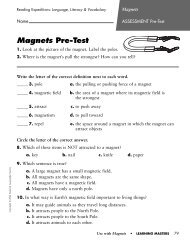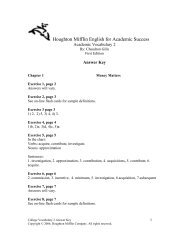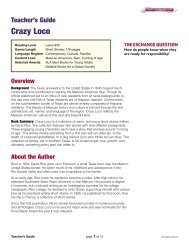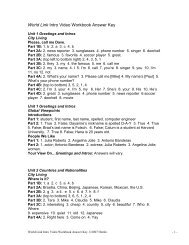English for Cabin Crew Trainer's Guide - Heinle
English for Cabin Crew Trainer's Guide - Heinle
English for Cabin Crew Trainer's Guide - Heinle
You also want an ePaper? Increase the reach of your titles
YUMPU automatically turns print PDFs into web optimized ePapers that Google loves.
UNIT<br />
3 After take-off and into the fl ight<br />
LEAD IN Speaking<br />
Ask students to look at the two photographs and say what they<br />
can see. Elicit as much vocabulary as you can to describe the<br />
photos (cabin; seats; passengers; overhead lockers; TV screens).<br />
Ask, What’s the difference between the two photos?<br />
Getting started<br />
EXERCISE 1 Speaking<br />
Ask students to discuss the questions in pairs or small groups. Then get<br />
feedback in open class.<br />
Pre-teaching vocabulary<br />
Check the following key phrases: sorry to bother you (sorry to interrupt<br />
you); a pretty tight connection (very little time between connections).<br />
EXERCISE 2 Listening<br />
Give students time to read the situation and questions. Ask, What do you<br />
think passengers might need or want in this situation? Play the recording.<br />
Students listen and then discuss their answers in pairs. Get feedback in<br />
open class at the end.<br />
Answers<br />
1 go to the toilet<br />
2 a glass of water<br />
3 heat her baby’s bottle<br />
4 how long it takes to get from Terminal 2 to Terminal 3<br />
EXERCISE 3 Listening<br />
Give students time to read the sentences and write in any words they<br />
think they know. Play the recording. Students listen, fi ll in the gaps and<br />
then check their answers in pairs. Get feedback in open class at the end.<br />
Answers<br />
1 sit 2 problem 3 course 4 help 5 with 6 soon 7 do 8 worry 9 get<br />
EXERCISE 4 Speaking<br />
Ask students to discuss this question in small groups. Then discuss in<br />
open class and encourage students to express their personal views.<br />
DEALING WITH PASSENGER NEEDS Language focus<br />
Give students time to read through the phrases in the box. Alternatively,<br />
read out the phrases and ask students to read and follow.<br />
Language notes<br />
Note the use of I’ll to make a promise.<br />
EXERCISE 5 Pronunciation<br />
Play the recording. Students listen and repeat.<br />
Pronunciation notes<br />
Note the rising intonation used to make offers and requests sound<br />
friendly and polite.<br />
➚<br />
Can I help you?<br />
➚<br />
Can you wait a moment?<br />
EXERCISE 6 Speaking<br />
Ask students to work in pairs. Ask each pair to decide who is A, and who<br />
is B, and to prepare what they are going to say be<strong>for</strong>e acting out the role<br />
play. Monitor, prompt students to use rising intonation correctly, and<br />
feedback on good examples of language use and errors you heard at the<br />
end. You could ask a couple of pairs to act out a dialogue in open class<br />
at the end.<br />
EXERCISE 7 Speaking<br />
Elicit ideas from the class, and open up a class discussion. Ask follow-up<br />
questions: What’s the most unusual request a passenger has made? What<br />
requests do you fi nd most annoying or diffi cult to deal with?<br />
ROUND UP<br />
Extend the role play in exercise 6 into a fun open class activity.<br />
Tell each student to imagine they are a passenger and to write<br />
down a need, a want and a query. Ask two students to stand up<br />
and walk round the class. They are the fl ight attendants and must<br />
respond to all the demands the rest of the class (the passengers)<br />
make of them. Tell the passengers to demand attention. This can<br />
be fun if the fl ight attendants have to deal with lots of queries.<br />
After a couple of minutes ask the fl ight attendants to exchange<br />
roles with two different students.<br />
13



